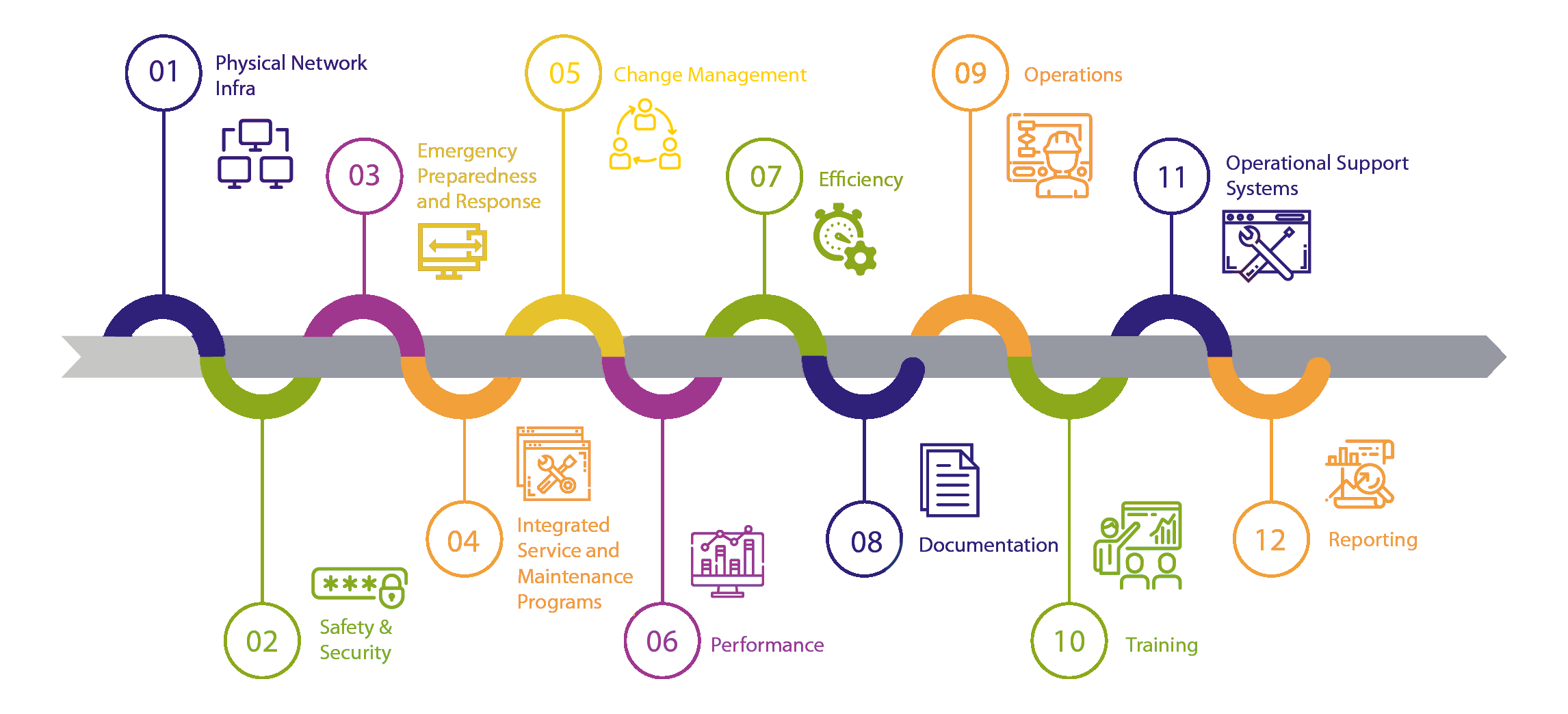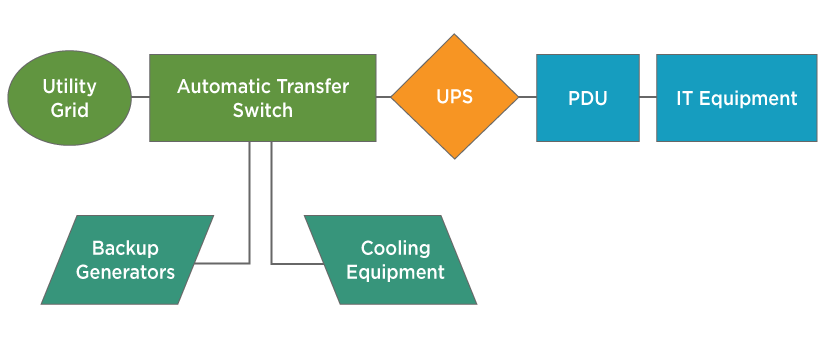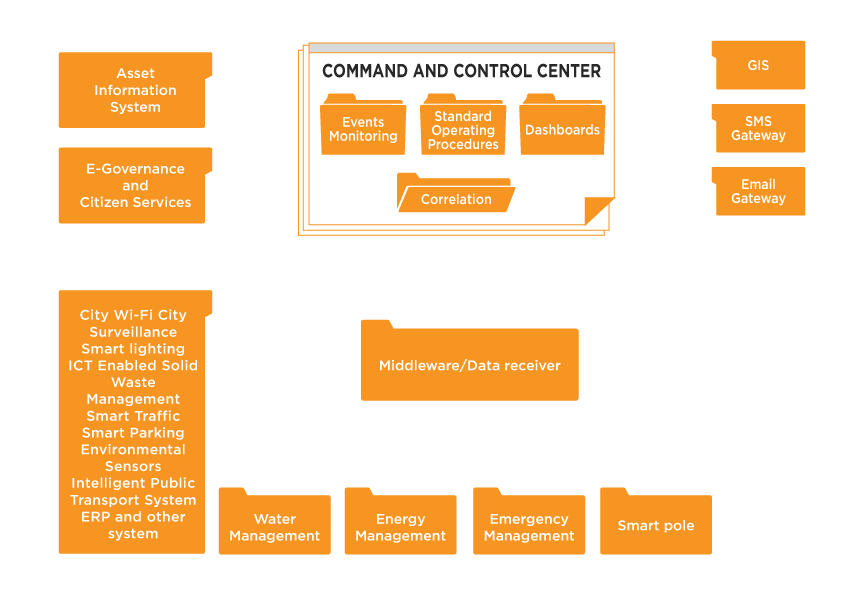
Our service team has the industry expertise, technical knowledge and solutions that improve energy efficiency, as well as the reliability of your critical IT environment.
While the structural elements of a data center are more or less similar to that of your typical office building, data centers are built to be much more solid and durable than other buildings would need to be, to preserve the equipment in the case of a natural disaster or any type of threat.
The IT equipment is what the data centre houses and protects and it’s what enables us to surf the web, navigate on our phones and use the apps that make our lives so much easier.
IT equipment can be identified into three categories:
Servers – These are responsible for running the software applications for things we do in our day-to-day lives, like send emails, design graphics, go on social media, or play our favorite game. They are like a laptop or computer except much more powerful and efficient.
Communication Gear – Communication, or networking gear, manages the safe & fast transfer of data in and out of the data center as well as between the IT equipment.
Storage equipment – This is where data like old emails, bank records and your social media uploads are stored.
The job of the electrical infrastructure is to transfer an uninterrupted supply of power from the utility grid or UPS to the IT equipment. This is crucial, as the data center cannot afford to lose power. If it did, we would not be able to accomplish even the smallest of tasks, from sending an email, to making a phone call or accessing our bank account. The power supply is designed such, that an alternate source of energy will continue powering the equipment, if a system should fail or lose power. The data center staff carefully monitors and manages the electrical infrastructure, to avoid any failures.
Below is a line diagram which illustrates the concept of how the power is transferred from the utility grid to the IT equipment:

As we can see, the utility grid provides the main source of power for the data center. Two separate utility grids are used for some facilities, in case one loses power. In the case of the utility grid losing power, diesel-powered generators produce backup electricity and can run for days, if need be.
The data center uses Automatic Transfer Switches (ATS) to switch from the utility grid to the backup generator without interruption, while the UPS (Uninterrupted Power Supplies) – which stores enough energy to bridge the gap – powers the IT equipment for the time it takes for the generators to start up. PDU (Power Distribution Units) contain multiple outlets, which the IT equipment is plugged into.
IT equipment generates a lot of heat that is capable of shutting it down, if it isn’t properly contained. It’s the job of the cooling infrastructure to remove the heat and keep all the IT equipment running smoothly. Most cooling units work the same way that air conditioners do – with a fan to regulate air flow and a cooling coil that removes the heat – except on a much larger scale.
The design experts and engineers at Cypress Solutions are amply trained and experienced to help our clients build a data centre facility of their tier level choice. Cypress Solutions’ experienced mission-critical infrastructure/data centre consulting team understands the specific requirements of mission critical facilities like yours and it is our goal to help you achieve 100% system availability in your data centre today and into the future.
To learn more about building a data center and the data center construction services that Cypress Solutions offers, or to speak with one of our Mission Critical Infra experts, please fill out our Contact Us form, or email us at sales@cypresssolutions.in.

Reduce costs without sacrificing reliability and uptime

Customized services to meet your business requirements

Tools, methods and procedures that improve system performance

Program performance tracking through KPI’s

Internal network of resources and technical expertise
The Smart Cities Framework enables cities to build a city- level digital platform that can integrate city data from various connected systems – vehicles, sensors from roadside infrastructure and buildings – and store that data in a manner that can be easily assimilated by city applications and citizens.
The City Level Digital Platform harnesses advances in digital technologies such as social, mobile, analytics, cloud and IoT in an integrated manner and transforms the way citizen services are delivered across key perspectives – liveability, security, mobility and sustainability.

The above diagram clearly conveys that the Command & Control Center is a place that houses the information processing units as well as controls the field devices, which makes it extremely important, physically as well as logically.
READ MORE
The design experts and engineers at Cypress Solutions are amply trained and experienced to help our clients build a Command & Control Center facility of their tier level choice. Cypress Solutions’ experienced mission critical infrastructure / command & control center facility consulting team understands the specific requirements of mission critical facilities like yours, and it is our goal to help you achieve 100% system availability in your Mission Critical Infrastructure today and into the future.
To learn more about building a Command & Control Center and the Command & Control Center related services that Cypress Solutions offers, or to talk with one of our Mission Critical Infra experts, please fill out our Contact Us form, or email us at sales@cypresssolutions.in.
Though there are differences in the definitions of intelligent design, the main ones primarily acknowledge the role of technology, without sufficient consideration of social, cultural and user interactions.
Others define intelligent buildings as automated buildings with flexibility, cost-efficiency and integrated technical performances.
Intelligent buildings emphasize an integrative effort to optimize the systems, structures, services and management of a building, in order to create a cost-effective, energy- efficient, and environmentally- approved environment for the occupants.
Smart building refers to environments such as:
 Apartments
Apartments Offices
Offices Museums
Museums Hospitals
Hospitals Schools
Schools Malls
Malls University campuses
University campuses Outdoor areas
Outdoor areas
Smart buildings involve “the use of integrated technological building systems, communications and controls to create a building and infrastructure that provides the owner, operator and occupant with an environment that is flexible, effective, comfortable and secure.”
READ MORE
Smart buildings are appointed with:
- A communications network
- Linking sensors
- Domestic appliances and other electronic devices that can be remotely monitored, accessed and controlled, and which provide services that respond to the needs of its residents.

The design experts and engineers at Cypress Solutions are amply trained and experienced to help our clients build a Smart & Intelligent Building facility of their choice. Cypress Solutions’ experienced mission critical infrastructure / command & control center facility consulting team understands the specific requirements of Smart & Intelligent Building facilities like yours, and it is our goal to help you achieve 100% Smart & Intelligent Building today and into the future.
To learn more about building a Smart & Intelligent Building and the Smart & Intelligent Building related services that Cypress Solutions offers, or to talk with one of our Mission Critical Infra experts, please fill out our Contact Us form, or email us at sales@cypresssolutions.in.
About 40% of the total energy consumption in the U.S. was used by residential and commercial sectors in 2016. The U.S. Energy Information Administration (EIA) publishes estimates for monthly, as well as annual, energy consumption by the residential and commercial sectors, and these sectors account for virtually all of the energy consumption in buildings. The commercial sector also includes street and outdoor lighting and water and sewage treatment, but these are comparatively small contributions to the consumption of the energy.
The EIA publishes comprehensive estimates for energy consumption in residential and commercial buildings as well as for heating, ventilation, cooling, and lighting in manufacturing facilities during specific years, but the data does not indicate the total energy consumption for the residential, commercial and industrial sectors for those years.
READ MORE
In India, the density of residential & commercial complexes is very high compared to U.S. based complexes, and therefore it is an important focal point in terms of reducing energy consumption. Because the materials that campuses are made of can be used as thermal mass, smart control of building HVAC systems can transform an ordinary office or residential building into a vast energy-storage network.
The energy consumption for a large-scale gated campus (e.g. a university campus) can be created using extensive amounts of data and an empirical model. Using this methodology, we can acquire advance information, enabling us to make proactive decisions about the system. Below are the prediction results for aggregate heating, cooling, and electrical load forecasts for a university campus of approximately 50,000 students. The forecast is made with information on the previous hours’ loads, the weather forecast for the next 24 hours, and the time and date.

The first step in optimizing the energy performance of campuses is to build smart process models that will predict the energy consumption and temperature inside a building – subject to environmental conditions, such as ambient temperatures and building occupancy. Using a forecast like this, along with utility pricing data, decisions regarding a building’s HVAC control can be made proactively (subject, of course, to the comfort constraints of the occupants). Heating, Cooling and Electrical Load Forecasting can help us make better usage of the energy taken and reduce the OPEX as much as possible.

By using such technologies a well-planned large campus can save huge amounts on CAPEX & OPEX (Operations Costs), without compromising on the quality of the products & services used.
The design experts and engineers at Cypress Solutions are amply trained and experienced to help our clients build a Smart & Intelligent Campus facility of their choice. Cypress Solutions’ experienced mission-critical infrastructure / Smart Campus Facility consulting team understands the specific requirements of mission critical facilities like yours, and it is our goal to help you achieve 100% system availability in your Campus today and into the future.
To learn more about building a Smart Campus and the Smart Campus related services that Cypress Solutions offers, or to talk with one of our Mission Critical Infra experts, please fill out our Contact Us form, or email us at sales@cypresssolutions.in.